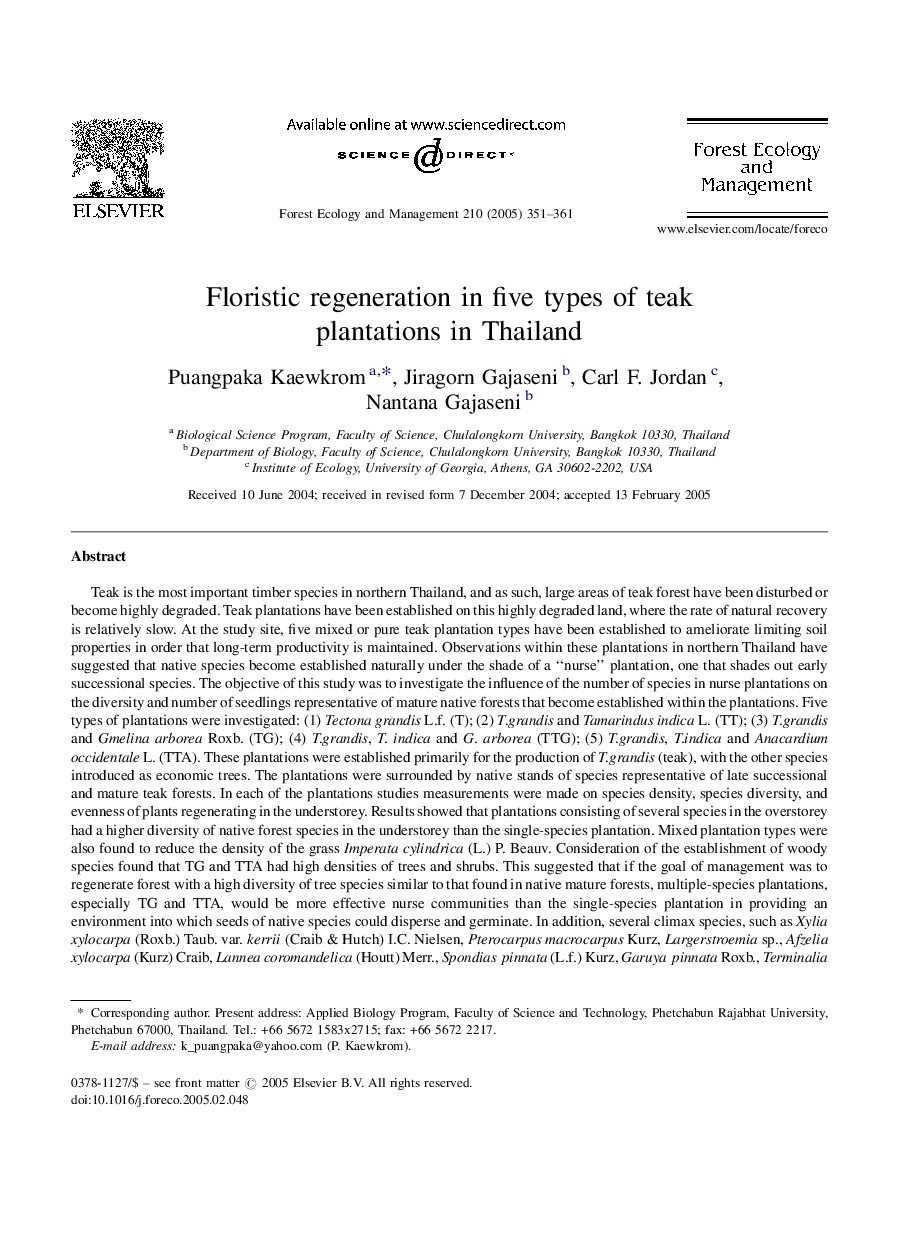| کد مقاله | کد نشریه | سال انتشار | مقاله انگلیسی | نسخه تمام متن |
|---|---|---|---|---|
| 9620375 | 159428 | 2005 | 11 صفحه PDF | دانلود رایگان |
عنوان انگلیسی مقاله ISI
Floristic regeneration in five types of teak plantations in Thailand
دانلود مقاله + سفارش ترجمه
دانلود مقاله ISI انگلیسی
رایگان برای ایرانیان
موضوعات مرتبط
علوم زیستی و بیوفناوری
علوم کشاورزی و بیولوژیک
بوم شناسی، تکامل، رفتار و سامانه شناسی
پیش نمایش صفحه اول مقاله

چکیده انگلیسی
Teak is the most important timber species in northern Thailand, and as such, large areas of teak forest have been disturbed or become highly degraded. Teak plantations have been established on this highly degraded land, where the rate of natural recovery is relatively slow. At the study site, five mixed or pure teak plantation types have been established to ameliorate limiting soil properties in order that long-term productivity is maintained. Observations within these plantations in northern Thailand have suggested that native species become established naturally under the shade of a “nurse” plantation, one that shades out early successional species. The objective of this study was to investigate the influence of the number of species in nurse plantations on the diversity and number of seedlings representative of mature native forests that become established within the plantations. Five types of plantations were investigated: (1) Tectona grandis L.f. (T); (2) T.grandis and Tamarindus indica L. (TT); (3) T.grandis and Gmelina arborea Roxb. (TG); (4) T.grandis, T. indica and G. arborea (TTG); (5) T.grandis, T.indica and Anacardium occidentale L. (TTA). These plantations were established primarily for the production of T.grandis (teak), with the other species introduced as economic trees. The plantations were surrounded by native stands of species representative of late successional and mature teak forests. In each of the plantations studies measurements were made on species density, species diversity, and evenness of plants regenerating in the understorey. Results showed that plantations consisting of several species in the overstorey had a higher diversity of native forest species in the understorey than the single-species plantation. Mixed plantation types were also found to reduce the density of the grass Imperata cylindrica (L.) P. Beauv. Consideration of the establishment of woody species found that TG and TTA had high densities of trees and shrubs. This suggested that if the goal of management was to regenerate forest with a high diversity of tree species similar to that found in native mature forests, multiple-species plantations, especially TG and TTA, would be more effective nurse communities than the single-species plantation in providing an environment into which seeds of native species could disperse and germinate. In addition, several climax species, such as Xylia xylocarpa (Roxb.) Taub. var. kerrii (Craib & Hutch) I.C. Nielsen, Pterocarpus macrocarpus Kurz, Largerstroemia sp., Afzelia xylocarpa (Kurz) Craib, Lannea coromandelica (Houtt) Merr., Spondias pinnata (L.f.) Kurz, Garuya pinnata Roxb., Terminalia mucronata Craib & Hutchison, Diospyoros mollis Griff., Irvingia malayana Oliv. ex Benn., Milletia leucantha Kurz, Dalbergia oliviri Gamble ex Prain, Chukrasia tabularis A. Juss and Schleichera oleosa (Lour.) Oken, were found in the early stages of succession, thus indicating that some may be suitable for planting in future restoration processes in order to accelerate natural succession and provide economic returns to managers.
ناشر
Database: Elsevier - ScienceDirect (ساینس دایرکت)
Journal: Forest Ecology and Management - Volume 210, Issues 1â3, 16 May 2005, Pages 351-361
Journal: Forest Ecology and Management - Volume 210, Issues 1â3, 16 May 2005, Pages 351-361
نویسندگان
Puangpaka Kaewkrom, Jiragorn Gajaseni, Carl F. Jordan, Nantana Gajaseni,